It’s hard to know how to categorize Quinn Gorbutt’s artwork, hovering as it does in the space between photography, sculpture, and painting. In the artist’s statement accompanying his exhibition, Heart, Mirror, Crown at Room 68 in Provincetown, he sympathizes with the viewer’s experience: “Inevitably the question arises: ‘But what exactly am I looking at?’ ”
“All tools are tools for art,” Gorbutt says, speaking from his Manhattan studio. “Whatever place you’re coming from, when you approach art, anything you pick up from that experience you can use.”
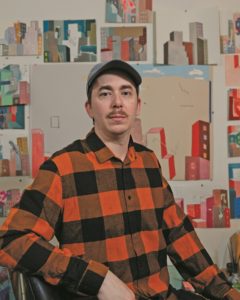
His exhibition features a sculpture created during a residency at Room 68 in March, a corresponding photograph, and a series of other large-scale photographs of constructed tableaux. The work reveals a range of tools used to create his images: paint, scraps of wood, and construction materials, all mediated by his camera.
Gorbutt’s freewheeling approach to making art developed while he took a circuitous path from a retail job in northern Virginia, where he grew up, to an M.F.A. from Yale. “I didn’t like school when I was young,” he says. After high school, he wasn’t eager to attend college. “I thought, at college, you have to pay to go do something you don’t want to do.”
Instead, he got a job at Michaels, the craft store. “I did well, got promotions,” he says. He was offered a job in management. But he reconsidered his path after a conversation with his boss. “My boss said, ‘Twenty-five years ago I got a job, and now here I am. I have this career.’ ”
“I don’t want that experience, actually,” Gorbutt recalls thinking. “If I imagined what my life was going to be, that wasn’t it.”
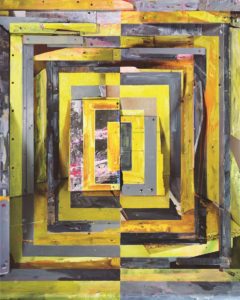
He painted and drew in his spare time. “Having played in bands and been a skateboarder, I would screen print and sign my own graphics, and do graffiti,” he says.
A friend suggested he study art. He kept working but enrolled at Northern Virginia Community College in Alexandria. Then, something clicked, leading him to continue his studies at MassArt in Boston. There, he delved deeper into photography — but he doesn’t call himself a photographer.
“There’s a lot of pressure from school to say, ‘I’m a painter, I’m a sculptor, I’m a photographer, I’m a performance artist,’ ” says Gorbutt. “Those are useful categories in the beginning to understand where art is coming from, but that is not what art is about.”
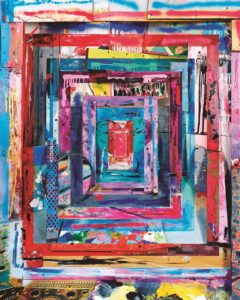
At one point he took a photograph of a building, achieving a complicated sense of perspective. It was a “satisfying visual experience,” says Gorbutt of the photograph. “The background and foreground start to change as you’re looking at it.”
He spent the next two weeks constructing an environment for one photograph. He was enjoying school now, but his rhythm didn’t match the pace of the photography program.
Later, Gorbutt found himself energized when a summer program at the Yale Norfolk School of Art offered an expansive sense of time. He considered the other visual interests he had abandoned in his singular pursuit of photography. In his graduate studies at Yale, he began building and painting sculptures as material for his photographs.
“It was a time to fine tune the thing that was itching at the back of my brain,” he says. “How do I get that out? How do I make that visible? How do I make someone else see that?”
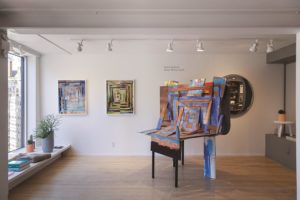
At Room 68, Gorbutt’s whole process is on view. A tabletop sculpture he built in Provincetown is composed of scraps of furniture, an old skateboard, and pieces of frames, and painted in slap-dash dripping strokes of blue and yellow ochre. He says he created the sculpture with the vantage point of the camera in mind. Looking at the sculpture that way, it becomes clear how Gorbutt composed it to complicate perspective, just like that seminal photo he took of a building while at MassArt.
Looking, Gorbutt explains, “the lines that your eyes are used to seeing, that give you a sense of perspective, start to disappear.” The resulting photograph, High Tide, reads like a flat abstract painting of concentric rectangles. It’s a fascinating play of space and illusion.
In addition to this pair of artworks, the exhibition features four other large-scale photographs of sculptures he has built. In Heart, Crown, Mirror, the exhibition’s titular piece, Gorbutt exposes his roots in graffiti. The photograph is a riot of color with surprising details, such as a mirror and the glossy surface of a plastic crown.
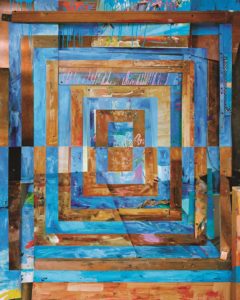
Gorbutt also collaborated with a virtual reality (VR) app, Kaleido, to further complicate the experience of viewing his photographs. After scanning Heart, Crown, Mirror on the app, the viewer experiences it in three dimensions, exposing the sculpture behind the photo — something made possible by the app’s integration of images shot from different angles while the piece was in Gorbutt’s studio.
The VR experience, along with the sculpture in the gallery, tells a narrative of how he builds his images. Yet, as Gorbutt explains, “It’s still pretty difficult to bridge the gap between the sculpture that you’re seeing and the precision and clarity in the photograph.” A sense of mystery remains in the surface of the photograph — a mediation that places the piece, however real, in a world of abstraction.
Heart, Mirror, Crown
The event: An exhibition of works by Quinn Gorbutt
The time: Now through June 15
The place: Room 68, 377 Commercial St., Provincetown
The cost: Free



